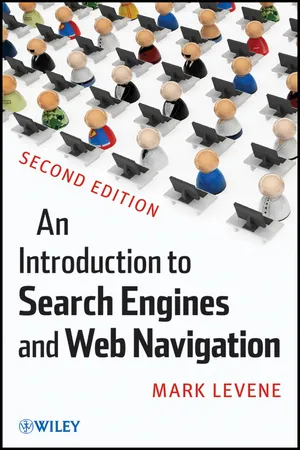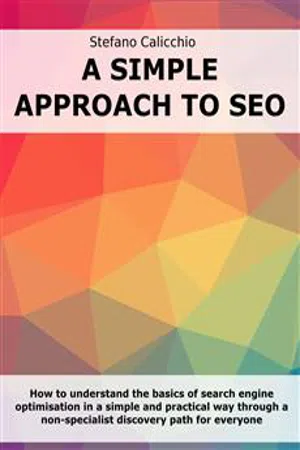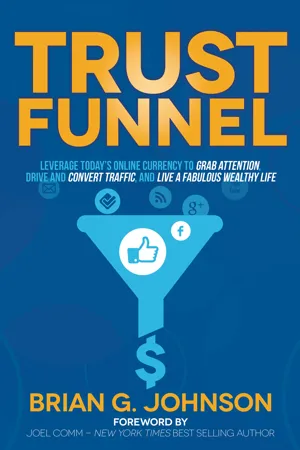PageRank Algorithm
PageRank Algorithm is an algorithm used by Google to rank web pages in search engine results. It assigns a numerical weight to each element of a hyperlinked set of documents, with the purpose of measuring its relative importance within the set. The algorithm works by analyzing the link structure of the web and has been a key factor in the development of search engine technology.
8 Key excerpts on "PageRank Algorithm"
- eBook - ePub
Social Networks
Modelling and Analysis
- Niyati Aggrawal, Adarsh Anand(Authors)
- 2022(Publication Date)
- CRC Press(Publisher)
...The algorithm assigns a numerical weight or rank to each page of a hyperlinked set of documents with the purpose of measuring its relative importance within the set. The PageRank Algorithm utilizes link structure of the web pages. This algorithm is query independent and it operates on the whole web and assigns a PageRank to every web page. PageRank utilizes the back link in deciding the rank score. P R u = ∑ v ∈ B u P R (v) L (v) (5.3) PageRank value for a web page u is dependent on the PageRank values for each web page v out of the set Bu (this set contains all pages linking to web page u), divided by the number L (v) of links from page v. Ranking of web pages by the Google search engine was initially determined by three factors: Page specific factors Anchor text of inbound links PageRank Algorithm: The PageRank Algorithm does not rank the whole website, but it's determined for each page individually. Furthermore, the PageRank of page A is recursively defined by the PageRank of those pages which link to page A. PageRank is a probability distribution used to represent the likelihood that a person randomly clicking on links will arrive at any particular page. Thus, a PageRank of 0.5 means there is a 50% chance that a person clicking on a random link will be directed to the document with the 0.5 PageRank. Brin and Page described the PageRank formula as [ 5 ] P R p i = 1 - d N + d ∑ p j ∈ M (p i) P R (p j) L (p j) (5.4) where p 1, p 2, …, p N are the pages under consideration, M (p i) is the set of pages that link to p i, L (p j) is the number of outbound links on page p j, N is the total number of pages and d is the damping factor. Damping Factor: The PageRank theory holds that any imaginary surfer who is. randomly clicking on links will eventually stop clicking. The probability, at any step, that the person will continue is called a damping factor d. The damping factor can be set to any value such that 0 < d < 1, but nominally it is set around 0.85...
- Mark Levene(Author)
- 2011(Publication Date)
- Wiley(Publisher)
...Brandt's view is that PageRank is the most important part of Google's ranking algorithm and that its search engine does not give content analysis its due significance in ranking query results. 19 To counter these claims, Chris Beasley has set up a web site to watch over Google-Watch (www.google-watch-watch.org) and put the record straight. He claims that PageRank is a mirror of the public's opinion on every web page and is thus an objective ranking measure. Although PageRank has received a lot of press as the feature distinguishing Google from other search engines and a main ingredient in its success, an important fact to remember is that PageRank is only one of many factors that Google uses to determine the rank of a web page, many of which were explained in the section of content relevance. Google's success in engineering a search engine that produces high-quality results, despite the heterogeneous nature of the web, its massive size, and the terse and underspecified makeup of user queries, is quite a feat. Google has raised the quality of search to higher levels than ever before, and has thus effectively raised our expectations as consumers of web searches. 5.2.4 PageRank Explained PageRank has an intuitive meaning in terms of a random surfer navigating through the Web by clicking on a randomly chosen link each time he browses a web page. The PageRank of a web page reflects the chance of the surfer arriving at the page. Thus the random surfer is continuously following links executing a random walk on the Web. Whenever the surfer has a choice between n outgoing links to click on he will choose any one of them with probability 1/ n ; in the special case when there are only two links to choose from, he can toss an unbiased coin in order to make a decision. The process the random surfer is going through can be modeled as a Markov chain, which we are familiar with from Section 3.4...
- eBook - ePub
Recent Trends in Communication and Electronics
Proceedings of the International Conference on Recent Trends in Communication and Electronics (ICCE-2020), Ghaziabad, India, 28-29 November, 2020
- Sanjay Sharma, Astik Biswas, Brajesh Kumar Kaushik, Vibhav Sachan, Sanjay Sharma, Astik Biswas, Brajesh Kumar Kaushik, Vibhav Sachan(Authors)
- 2021(Publication Date)
- CRC Press(Publisher)
...Link popularity concept was developed for the superiority search results and to resist automatically generated web pages basically based on content specific ranking criteria. Depending on this concept, general importance is measured by the number of inbound links. Hence, the importance and priority of a web page is high, if other web pages interlink to it. Good ranking for pages are often escaped by the concept of link popularity, which are only created to deceive search engines and having no implication within the web, but numerous web provide manipulate just by creating multitude of incoming links for doorway pages from just as meaningless other web pages. 2 Related Work Author has proposed combination of strategies for the link analysis algorithm. It is proposed for getting the pages which are more relevant to the user’s domain. For the prototype in this paper structured data is used for betterment of the results. The experimental results show that there is minute increment in the rate of harvest of the results. Rating the links is major part on which crawler depends which in return enhance the mechanism of discovery (Chahal et al. 2014). Author proposed a model to find importance of any web page using back link location. Web page link and content is annotated by its location and this has been used to find geographic rank of the web page. Accurate geo-ranking results has been shown using location based queries. Re-ranking of the search engine results are also based on the Location-based query (Koundal. 2014). Local graph is always build for each query as in the HITS (Hyperlink induced Topic Search) algorithm and finds out the new geographic rank from the graph based upon the locations annotated with the back links. As HITS and PageRank requires initial rank-score, this model do not require rank-score as for root data set. Model offers more accurate rank of results model for locale web pages...
- eBook - ePub
A simple approach to SEO
How to understand the basics of search engine optimisation in a simple and practical way through a non-specialist discovery path for everyone
- Stefano Calicchio(Author)
- 2021(Publication Date)
- Stefano Calicchio(Publisher)
...When a valuable site (with a good starting PR) links to another site, it will pass on part of its pagerank to the linked site. Similarly, receiving links (votes) from sites that are considered bad will contribute to a decrease in pagerank, thus creating a penalty in the search results. Obviously, the functioning of the page rank that you have just read is a simplification of how Google and other search engines really operate; in practice, the programmers of the algorithms have implemented thousands of variations to the principle of link voting. It must be remembered that their aim is to increasingly refine the results expressed by the search engines, in order to make them more reliable and appreciated by the numerous users. It is interesting to note that similar algorithms also operate in e-commerce portals such as Amazon, or in social networks. We can therefore state that the presence of links from external sites has two types of influences on the work to be done by the SEO consultant...
- eBook - ePub
Trust Funnel
Leverage Today's Online Currency to Grab Attention, Drive and Convert Traffic, and Live a Fabulous Wealthy Life
- Brian G. Johnson(Author)
- 2015(Publication Date)
- Morgan James Publishing(Publisher)
...Not surprisingly, the popularity of Google grew at a feverish pace. The Google algorithm that determined which webpages ranked well and which did not was based on how webpages linked to one another. This was a massive departure from other search engines that were based on content and keyword phrases found on the webpage itself. Thus, search rankings were easy for webmasters to manipulate. With the Google search engine, rankings were harder to game as they were determined by how other webpages linked to a particular webpage. Ultimately, Google had a better, more secure algorithm that delivered better results for its users... for a while anyway. POWERED BY ROBOTS: THE ACHILLES HEEL FOR GOOGLE During this time, Google delivered better results to its users. However, those results were still determined by robots. Google robots crawled the web and collected data that was based on factors that, in time, were easy to exploit. Links played a massive role in which webpages ranked and which ones did not. Thus, webmasters got really creative in feeding the robots the very thing that increased rankings: links. Webmasters began trading “reciprocal links,” established “link farms” to boost rankings, and various software packages became available that built links nearly at the push of a button. However, as the years passed it became increasingly hard to manipulate their algorithm, and while links have always played a big role, other factors such as trust became increasingly important in establishing high Google rankings. THE PIVOT: GOOGLE, FACEBOOK, “LIKES,” AND HUMANOIDS This is the pivot and it’s also where we dip our toe into the theory of the Google search algorithm. Once Google begins to implement social signals into its algorithm, humans will influence the rankings. Think about that. Social engagement (likes, shares, and comments found on blogs and social sites like Facebook, Twitter, and Google+) are based on human activity...
- eBook - ePub
Public Relations and the Social Web
How to Use Social Media and Web 2.0 in Communications
- Rob Brown(Author)
- 2009(Publication Date)
- Kogan Page(Publisher)
...Search engines were going to have to improve the way that they found information or searching would become increasingly unreliable. Two students at Stanford University, Larry Page and Sergey Brin, created a search engine technique based on mathematical algorithms that measured links from one website to another. This was the basis for Google, the search engine they launched in 1998. The search engine optimization business started to find ways to manipulate this new form of search. In short, they found ways of creating spurious links to the sites that they wanted to promote using devices such as link farms, which involved the creation of thousands of websites whose only function was to provide links to the original site to improve its page rank. SEO became an important element in any digital marketing campaign. SEO expanded to look at the actual functioning of the search algorithms and would review code, presentation and structure of websites to improve their ranking. All of the leading search engines, Google, Microsoft Search and Yahoo! use web crawlers to find pages automatically. High page rankings can have a huge commercial value and therefore there continues to be a tension between the SEO business and optimal function of search engines. The techniques are regarded as being either good design that search engines approve of, or they are regarded as ‘black hat’ or attempts to trick search engines into providing a higher rank than a site actually merits. This will usually lead to these sites being banned temporarily or permanently once the search engines discover black hat techniques. For example using text that is hidden from human eyes but visible to a search engine. Some major international companies, such as BMW, have been accused of using some of these techniques and have been the subject of temporary bans by Google...
- eBook - ePub
Marketing in the Age of Google, Revised and Updated
Your Online Strategy IS Your Business Strategy
- Vanessa Fox(Author)
- 2012(Publication Date)
- Wiley(Publisher)
...Chapter 5 How Search Engines Work We’ve seen how searchers behave and how they interact with search results. We’ve decided what queries we want our sites to be found for. How do search engines compile these lists? THE EVOLUTION OF SEARCH ENGINES In the emerging days of the Web, directories were built to help users navigate to various websites. Generally, these directories were created by hand—people categorized websites so that users could browse to what they wanted. As the Web got larger, this effort became more difficult. Web spiders that “crawled” websites were created. Web spiders, also known as robots, are computer programs that follow links from known web pages to other web pages. These robots access those pages, download the contents of those pages (into a storage mechanism generically referred to as an “index”), and add the links found on those pages to their list for later crawling. Although Web crawlers enabled the early search engines to have a larger list of sites than the manual method of collecting sites, they couldn’t perform the other manual tasks of figuring out what the pages were about and ranking them in order of which ones were best. These search engines started working on computer programs that would help them do these things as well. For instance, computer programs could catalog all the words on a page to help figure out what those pages were about. THE INTRODUCTION OF PAGERANK Google’s PageRank Algorithm in 1998 was a big step forward in automatically cataloging and ranking websites. 1 This algorithm used data from the links on the Web to determine what pages were about and which pages were more popular and useful. Links were like votes for a site, and the text from those links was used for cataloging them. For instance, consider two web pages. One is at the address www.myusedcars.com, and the other is at the address www.yourusedcars.com. Both contain text about cars and have the title “Used Cars.” Five websites link to www.myusedcars.com...
- eBook - ePub
Algorithmic Life
Calculative Devices in the Age of Big Data
- Louise Amoore, Volha Piotukh, Louise Amoore, Volha Piotukh(Authors)
- 2015(Publication Date)
- Routledge(Publisher)
...Crucially, this mechanism is not just the tyranny of the majority, because Google’s algorithm assigns different weights to different ‘voters’, as the name ‘PageRank’ indicates. This arguably introduces a conservative flavour in the political philosophy of the algorithm. Older websites have had more chances to accumulate hyperlinks pointing to them, something that Google interprets as a sign of ‘wisdom’ and values with a higher PageRank, that is, a vote that counts more. As such, Google can be said to show a certain respect for the ‘elders’, with arguably positive and negative implications. Google may be granted to ‘bring order’, but this order has been pointed out to come at the price of ‘winner takes all’ effects (Marres, 2012c). We suggest that the caricature of this vision of the just public, which will allow us to operationalise it for the purpose of ordering a dataset of research papers, is the following rule: articles vote for each other through links (citations), and votes from articles that have received many links themselves (that have been cited more), count more. Facebook At Facebook (2014), they seek to: “give people the power to share and make the world more open and connected”. Here we also find an indication of a common good and a truth about how to achieve it. The common good is a world that is open and connected. The truth is that this common good is produced when people are given the power to share. Contrary to Google, the ambition is not to produce a universal ordering, but rather a multitude of situated orderings based on personal connections and privileged sharing. This is pursued in practice by Facebook’s newsfeed, where relevance is based on the so-called ‘EdgeRank’ algorithm. This algorithm qualifies and prioritises content based on evaluations of previous interactions and connections (‘edges’), such as posts, comments, and ‘likes’ from friends...







